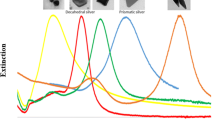Abstract
We investigated intrinsic noise in plasmonic sensors caused by adsorption and desorption of gaseous analytes on the sensor surface. We analyzed a general situation when there is a larger number of different analyte species. We applied our model to calculate various analyte mixtures, including some environmental pollutants, toxic and dangerous substances. The spectral density of mean square refractive index fluctuations follows a dependence similar to that of generation-recombination noise in photodetectors, flat at lower frequencies and sharply decreasing at higher. Some of the calculated noise levels are well within the detection range of conventional surface plasmon resonance sensors. An AD noise peak is observed in temperature dependence of mean square refractive index fluctuations, thus sensor operating temperature may be optimized to obtain larger signal to noise ratio. A significant property of AD noise is its rise with the decreasing plasmon sensor area, which means that it will be even more pronounced in modern nanoplasmonic devices. Our consideration is valid both for conventional surface plasmon resonance devices and for general nanoplasmonic devices.









Similar content being viewed by others
References
Abdulhalim I, Zourob M, Lakhtakia A (2008) Surface plasmon resonance for biosensing. Electromagnetics 28:214–242. doi:10.1080/02726340801921650
Antonyuk BP, Musichenko SF, Podobedov VB (1997) 1/ω noise in refractive-index fluctuations in As2Se3 glass. Opt Commun 142:220–222. doi:10.1016/S0030-4018(97)00335-0
Bingham CM, Tao H, Liu X, Averitt RD, Zhang X, Padilla WJ (2008) Planar wallpaper group metamaterials for novel terahertz applications. Opt Express 16:18565–18575. doi:10.1364/OE.16.018565
Brolo AG, Gordon R, Leathem B, Kavanagh KL (2004) Surface plasmon sensor based on the enhanced light transmission through arrays of nanoholes in gold films. Langmuir 20:4813–4815. doi:10.1021/la0493621
Cai W, Shalaev V (2009) Optical metamaterials: fundamentals and applications, Springer, Dordrecht. doi:10.1007/978-1-4419-1151-3
Chinowsky TM, Quinn JG, Bartholomew DU, Kaiserc R, Elkind JL (2003) Performance of the Spreeta 2000 integrated surface plasmon resonance affinity sensor. Sens Actuators B 91:266–274. doi:10.1016/S0925-4005(03)00113-8
Djurić Z, Jakšić O, Randjelović D (2002) Adsorption-desorption noise in micromechanical resonant structures. Sens Actuators A 96:244–251. doi:10.1016/S0924-4247(01)00834-2
Glenn WH (1989) Noise in interferometric optical systems: an optical Nyquist theorem. IEEE J Quantum Electron 25:1218–1224. doi:10.1109/3.29251
Homola J (2006) Surface plasmon resonance based sensors. Springer, Berlin. doi:10.1007/b100321
Ishimaru A, Jaruwatanadilok S, Kuga Y (2005) Generalized surface plasmon resonance sensors using metamaterials and negative index materials. Prog Electromagn Res 51:139–152. doi:10.2528/PIER04020603
Jakšić Z, Djurić Z (2004) Cavity enhancement of Auger-suppressed detectors: a way to background-limited room-temperature operation in 3–14 micrometer range. IEEE J Sel Top Quantum Electron 10:771–776. doi:10.1109/JSTQE.2004.833976
Jakšić Z, Jakšić O, Djurić Z, Kment C (2007) A Consideration of the use of metamaterials for sensing applications: field fluctuations and ultimate performance. J Opt A 9:S377–S384. doi:10.1088/1464-4258/9/9/S16
Jakšić Z, Jakšić O, Matović J (2009) Performance limits to the operation of nanoplasmonic chemical sensors—noise equivalent refractive index and detectivity. J Nanophotonics 3(031770):1–13. doi:10.1117/1.3124792
Jung LS, Campbell CT, Mar MN, Yee SS (1998) Quantitative interpretation of the response of surface plasmon resonance sensors to adsorbed films. Langmuir 14:5636–5648. doi:10.1021/la971228b
Kabashin AV, Evans P, Pastkovsky S, Hendren W, Wurtz GA, Atkinson R, Pollard R, Podolskiy VA, Zayats AV (2009) Plasmonic nanorod metamaterials for biosensing. Nat Mater 8:867–871. doi:10.1038/nmat2546
Liu Y, Bishop J, Williams L, Blair S, Herron J (2004) Biosensing based upon molecular confinement in metallic nanocavity arrays. Nanotechnology 15:1368–1374. doi:10.1088/0957-4484/15/9/043
Maier SA (2007) Plasmonics: fundamentals and applications. Springer, Berlin
Maissel LI, Glang R (1970) Handbook of thin film technology. McGraw-Hill, New York
O’Hara JF, Singh R, Brener I, Smirnova E, Han J, Taylor AJ, Zhang W (2008) Thin-film sensing with planar terahertz metamaterials: sensitivity and limitations. Opt Express 16:1786–1795. doi:10.1364/OE.16.001786
Piliarik M, Homola J (2009) Surface plasmon resonance (SPR) sensors: approaching their limits? Opt Express 17:16505–16517. doi:10.1364/OE.17.016505
Slavik R, Homola J (2007) Ultrahigh resolution long range surface plasmon-based sensor. Sens Actuators B 123:10–12. doi:10.1016/j.snb.2006.08.020
van Vliet KM, Fasset JR (1965) Fluctuations due to electronic transitions and transport in Solids. In: Burgess RE (ed) Fluctuation phenomena in solids. Academic Press, New York
Vig J, Kim Y (1999) Noise in microelectromechanical system resonators. IEEE Trans Ultrason Ferroelect Freq Contr 46:1558–1565. doi:10.1109/58.808881
Yong YK, Vig JR (1989) Resontor surface contamination–a cause of frequency fluctuations. IEEE Trans Ultrason Ferroelect Freq Contr 36:452–458. doi:10.1109/58.31783
Acknowledgments
This work was partially funded by the Austrian Science Fund (FWF) within the project L521 “Metal-composite Nanomembranes for Advanced Infrared Photonics” and by the Serbian Ministry of Science and technology within the project 11027 “Microsystem and Nanosystem Technologies and Devices”.
Author information
Authors and Affiliations
Corresponding author
Rights and permissions
About this article
Cite this article
Jakšić, O., Jakšić, Z. & Matović, J. Adsorption–desorption noise in plasmonic chemical/biological sensors for multiple analyte environment. Microsyst Technol 16, 735–743 (2010). https://doi.org/10.1007/s00542-010-1043-7
Received:
Accepted:
Published:
Issue Date:
DOI: https://doi.org/10.1007/s00542-010-1043-7




